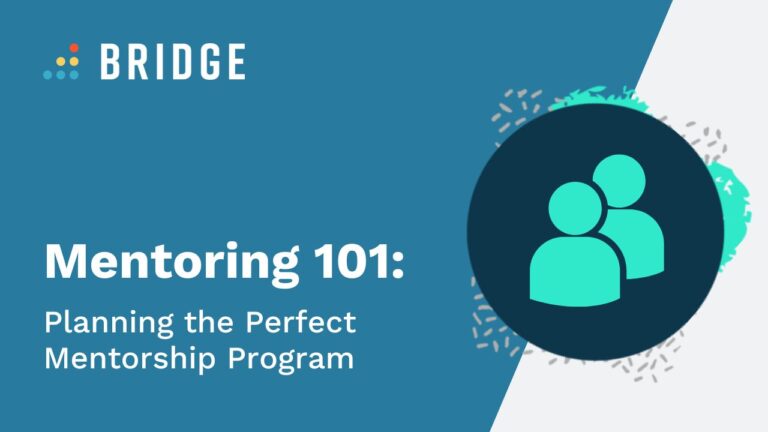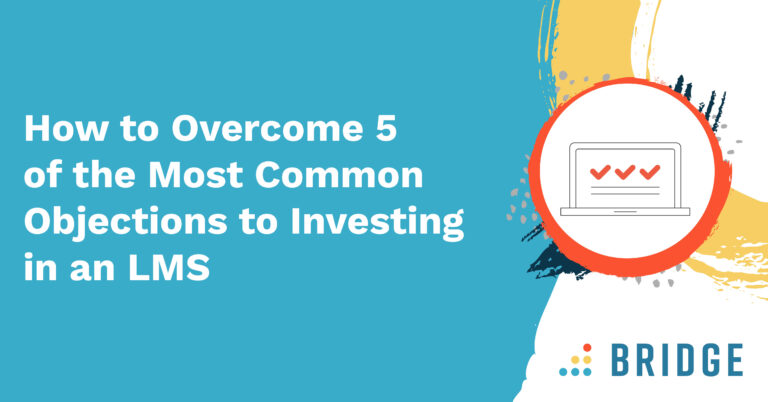There’s no aspect of learning, skill development, or life that doesn’t benefit from a good plan. Having said that, mentorship is an area that particularly benefits from a thoughtful approach.
After all, if you boil mentorship down to its fundamentals, you’re left with two (or more) people having a conversation. This is a great way to foster friendliness and informality, but it’s also a slippery slope from a casual chat to a complete loss of structure—which isn’t ideal when you’re trying to help mentees achieve concrete goals.
As such, HR professionals looking to conjure up a cohesive mentoring program will benefit from thinking carefully about the program’s objectives, establishing clear guidelines for mentors and mentees, and identifying models of mentorship that slot right into their organization’s existing capabilities.
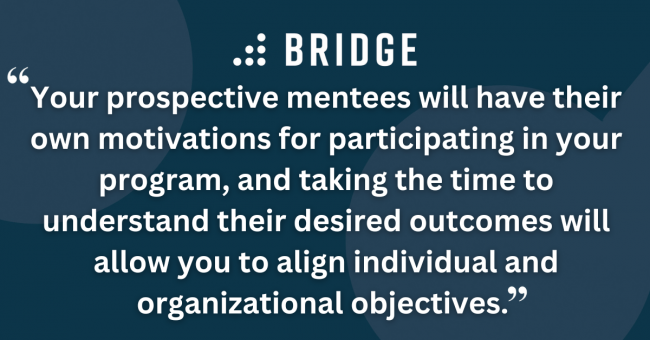
Defining Goals and Objectives
Your planning process needs to begin with an assessment of what your organization is looking to get out of its mentoring program.
Your organization might want to:
- Encourage a general culture of learning and development in which mentorship is one development tool among many
- Bolster your succession planning by ensuring your future leaders are in the hands of the most qualified individuals possible
- Improve your DE&I efforts by providing every opportunity for advancement among all demographics in your organization
- Increase employee retention levels by facilitating internal mobility and fostering engagement
Organizational goals aren’t the only factor to consider. Your prospective mentees will have their own motivations for participating in your program, and taking the time to understand their desired outcomes will allow you to align individual and organizational objectives. Encourage your people to reflect on what they want to get out of their mentoring experiences: do they want to bolster their current skillsets and advance to the next stage of their careers? Or are they more interested in making new connections and exploring other parts of your organization?
There’s a lot of room for overlap between individual and organizational goals, and there are plenty of ways mentorship can support every stakeholder’s objectives. If you’re looking to improve your succession plans and your people want to prepare themselves for advancement, it’s not difficult to see how these aspirations line up. The important thing is to clearly articulate what your organization’s goals are, ensuring that your people can justify how their personal goals for pursuing mentorship fit into your organization’s grand designs.
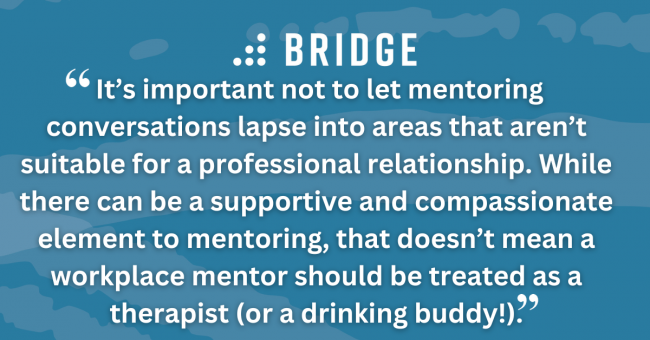
Establishing a Code of Conduct
Putting your stamp on mentoring-related objectives is a great first step, but good intentions are only as powerful as the way they’re implemented. And, while mentoring programs come with obvious implementation challenges like the technologies involved, the techniques used, and the practices surrounding evaluation, there are subtler considerations to think about before you get there. In a nutshell: it’s all about the etiquette.
It’s easy to overlook the question of how mentors and mentees should behave—after all, everyone involved is a professional—but mentoring can introduce interpersonal ambiguities that need a touch of clarification. For example, a mentor-mentee relationship often involves hierarchical differences, which might lead to a mentee feeling too nervous or deferential to provide an honest assessment of their aims or progress. At the same time, it’s important not to let mentoring conversations lapse into areas that aren’t suitable for a professional relationship. While there can be a supportive and compassionate element to mentoring, that doesn’t mean a workplace mentor should be treated as a therapist (or a drinking buddy!).
You can ensure your people keep the conversation friendly and respectful by establishing a code of conduct. By clearly outlining what appropriate communication and behavior look like, you’ll have no trouble ensuring that your mentors and mentees are comfortable, happy, and getting the most out of the process. In turn, your code of conduct might fall under a broader mentorship agreement or contract, covering areas like:
- The roles and responsibilities of both parties
- The need for confidentiality in a mentor-mentee relationship
- The duration of the mentoring process
- Provisions for dispute resolution, like alerting a coordinator in the event of disagreements
READ MORE ABOUT MENTORING | ‘How Org Charts Can Help Workplace Mentorship Programs’
Identifying 4 Key Mentoring Models
You might know how you want your mentors and mentees to conduct themselves, but that still leaves an important question unanswered as you plan the perfect program: what form should your mentoring sessions take? Do you want to stick to a strictly one-on-one interaction between a senior and junior employee? Or are you interested in newer methods that reverse the hierarchical relationship or eliminate it altogether?
You won’t know for sure until you’ve given each option a few moments of consideration—so consider these four well-established mentorship models.
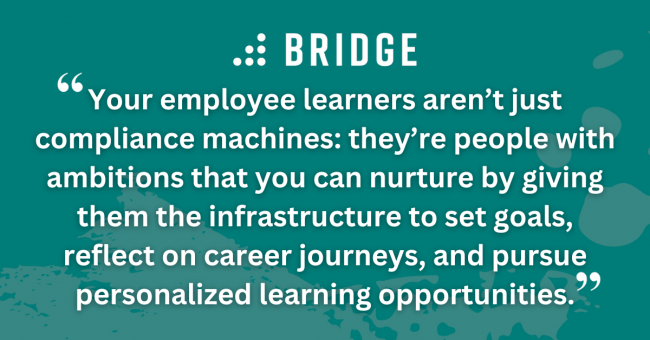
1) One-on-One Mentoring
As the bread and butter of the mentoring world, one-on-one (or ‘dyadic’) mentoring will likely have the most familiar feel. This is the baseline from which other mentoring options stem—and with good reason! It allows employees to foster a strong connection with a senior colleague who they might not otherwise get to know on a personal level.
There are plenty of practical advantages to this most basic form of mentoring relationship. Gaining a little wisdom from a direct manager is the perfect way for your people to climb the ladder, assuming the ladder they’re on is the ladder they plan on sticking with. However, it’s worth bearing in mind that you can add a twist to the formula by offering mentoring opportunities with mentors from other parts of your organization. This approach allows mentees to gain skills in other domains or disciplines, and could easily act as the spark that will go on to ignite a whole new career by facilitating internal movement within your organization.
GET THE LOWDOWN ON TALENT MOBILITY | ‘The 5 Pillars of a Successful Talent Mobility Strategy and How to Leverage Them’
2) Group Mentoring
According to a study of academic mentorship, successful mentoring requires that both sides are “willing to invest the time and energy to develop their interactions.” This is a fine conclusion—but sometimes willingness isn’t the only factor involved. When you’re dealing with a senior employee, they simply might not have the time to give, no matter how great an investment mentoring may be.
In that scenario, the benefits of group mentorship heavily suggest themselves as a handy alternative to time-consuming one-on-one interactions. Rather than dropping a dozen pearls of wisdom into the minds of a dozen mentees, a group mentor can—like one of the more efficient breeds of oyster—produce a single time-efficient pearl for the whole cohort to enjoy.
3) Peer Mentoring
If your senior colleagues are too busy to commit to mentorship, group mentoring isn’t the only option. After all, mentors can come in all shapes, sizes, and levels of seniority—and there are plenty of circumstances in which a peer can take on the mantle of mentor, maximizing the amount of mentoring time your people receive.
Peer mentoring works best between colleagues of the same level who have differing levels of experience. Some organizations recommend a similar approach to supplement the onboarding process by assigning new hires a ‘buddy’ to help them through the early stages. Alternatively, mentees looking for a change in career direction might turn to a mentor of the same level in your company hierarchy who holds a completely different role, allowing for reskilling with a view to a lateral move down the road.
There’s no question that peers can offer just as many mentoring-related benefits as their more senior colleagues. One study of engineering students found that, when mentees were matched with an appropriate mentor, they achieved better academic outcomes, experienced improved aspirations, and reported better emotional wellbeing.
In this case, the best results came when female engineering students were assigned female peer mentors. As the authors point out, this is consistent with the established sociological idea that students who are considered a minority in a given discipline find better chances of professional success when they’re given opportunities (like mentoring) to develop peer networks comprising other minority individuals. Peer mentoring widens organizations’ nets and facilitates these connections, and this is well worth doing. As the Gallup Center on Black Voices finds, mentors “propel development, foster engagement, and facilitate positive organizational perceptions,” and employees with mentors are 58% more likely to strongly agree that their workplace gives all employees equal advancement opportunities.
4) Reverse Mentoring
There’s a memorable moment in the 1971 film Willy Wonka and the Chocolate Factory in which Charlie Bucket’s teacher is horrified at the thought of being taught something by his students. “If you knew and I didn’t know,” he says, “then you’d be teaching me instead of me teaching you—and for a student to be teaching his teacher is presumptuous and rude.”
Luckily, today’s workplace mentoring practices don’t agree with this theory of teaching. In fact, the key principle of reverse mentorship is that senior and leadership colleagues aren’t infallible and always have more to learn. In particular, organizations are using reverse mentoring to help leaders to gain more intergenerational awareness, technical savvy, and understanding of diversity and inclusion issues. Though these are soft skills, a good talent platform will be able to allow for these categories within its skills taxonomy, allowing junior staff members to offer up mentoring services within these fields.
Though this idea has only gained traction in more recent times, studies already indicate the practical benefits of incorporating reverse mentoring into your broader mentoring program. An article from the world of healthcare, for example, concluded that reverse mentoring can cross hierarchical divides, and acknowledges that it also offers a way for senior doctors to receive important feedback from their junior colleagues.
Want to Put Your Program Into Practice?
Find out how to match your mentors to eager mentees and maintain your program well into the future with the help of our full ebook, ‘3 Elements of a Successful Mentorship Program.’
